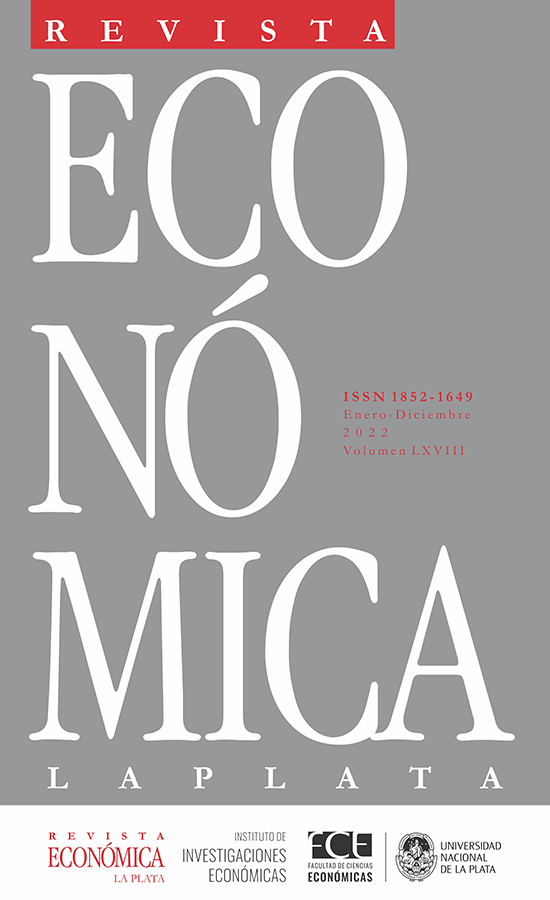Education and Economic Growth: Considering Non-linearities in the Mincer Equation
DOI:
https://doi.org/10.24215/18521649e027Keywords:
Mincer equation, growth, education, years of studyAbstract
This work aims to estimate the impact of the increase in the years of study of the population on the stock of human capital and on economic growth. Based on different possible specifications for the Mincer equation, we derive bounds for the relationship between years of study and the stock of human capital at the aggregate level. Using a panel of 99 countrie, we estimate the long-term relationship between GDP per worker and of human capital using the DOLS method. We conclude that both the years of education and the quality of them are important determinants of economic growth.
Downloads
Metrics
References
Alejo, J. y Funes, V. (2021). Ecuaciones Salariales de parejas bajo selección muestral bivariada. Una aplicación al caso argentino. Revista de Análisis Económico, 36(1), 3-22.
Becker, G. (1962). Investment in Human Capital: A Theoretical Analysis. Journal of Political Economy, 70(5), 9-49.
Angrist, N., Djankiv, S., Goldberg, P. y Patrinos, H. (2021). Measuring human capital using global learning data. Nature, 592, 403-408.
Altinok, N., Angrist, N. y Patrinos, H. (2018). Global data set on education quality (1965-2015). World Bank Group Policy, WPS 8314.
Barro, R. y Lee, J. (2013). A new data set of educational attainment in the world, 1950-2010. Journal of Development Economics, 104(C), 184-198.
Belzil, C. (2008). Testing the specification of the mincer wage equation. Annales d´Economie et de Statistique (91/92), 427-451.
Benhabib, J. y Spiegel, M. (1994). The role of human capital in economic development: evidence from aggregate cross-country data.Journal of Monetary Economics, 34(2), 143-173.
Bils, M. y Klenow, P. (2000). Does schooling cause growth? American Economic Review, 90(5), 1160-1183.
Boot, J., Feibes, W. y Lisman, J. (1967). Further methods of derivation of quarterly figures from annual data. Applied Statistics, 16(1), 65-75.
Breton, T. (2011). The quality vs. the quantity of schooling: What drives economic growth? Economics of Education Review, 30(4), 765-773.
Choi, I. (2001). Unit root test for panel data. Journal of International Money and Finance, 20(2), 249-272.
Cohen, D. y Soto, M. (2007). Growth and human capital: good data, good results. Journal of Economic Growth, 12(1), 51-76.
Denton, F. (1971). Adjustment of monthly or quarterly series to annuals totals: An approach based on quadratic minimization. Journal of the American Statistical Association, 66(333), 99-102.
Deschenes, O. (2001). Unobserved ability, comparative advantage, and the rising return to education in the United States 1979-2000. Department of Economics.
Feenestra, R., Inklaar, R. y Timmer, M. (2015). The next generation of the Penn World Table. American Economic Review, 105(10), 315-82.
Hanushek, E. (2013). Economic growth in developing countries: The role of human capital. Economics of Education Review, 37(C), 204-212.
Hanushek, E. y Woessmann, L. (2008). The Role of Cognitive Skills in Economic Development. Journal of Economic Literature, 46(3), 607-668.
Jin, S., Phillips, P. y Sun, Y. (2006). A new approach to robust inference in cointegration. Economics Letters, 91(2), 300-306.
Kao, C. y Chiang, M. (2000). On the estimation and inference of cointegrated regression in panel data. En B. Baltagi, Nonstationary Panels, Panel Cointegration, and Dynamic Panels (Advances in Econometrics) (pp. 161-178). JAI Press.
Lindhal, M. y Krueger, A. (2001). Education for Growth: Why and for Whom? Journal of Economic Literature, 39(4), 1101-1136.
Lucas, R. (2014). On the mechanics of economic development. Journal of Monetary Economics, 22(1), 3-42.
Mincer, J. (1974). Schooling, experience, and earnings. National Bureau of Economic Research, Inc.
Montenegro, C. y Patrinos, H. (2014). Comparable estimate of returns to schooling around the worls. The World Bank, Policy Research Working Paper Series n.° 7020.
Pedroni, P. (1999). Critical values for cointegration test in heterogeneous panels with multiple regressors. Oxford Bulletin of Economics and Statistics, 61(S1), 653-670.
Phillip, P. y Moon, H. (1999). Linear regression limit theory for nonstationary panel data. Cowless Foundation for Research in Economics, Yale University, Cowless Foundation Discussion Papers n.°1222.
Poschke, M. (2018). The firm size distribution across countries and skill-biased change in entrepreneurial technology. American Economic Journal: Macroeconomics, 10(3), 1-41.
Pritchett, L. (2001). Where all the education gone? The World Bank Economic Review, 15(3), 367-391.
Psacharopoulos, G. (1985). Returns to education: A further international update and implications. Journal of Human Resources, 20(4), 583-604.
Psacharopoulos, G. (1994). Returns to investment in education: A global update. World Development, 22(9), 1325-1343.
Rodriguez Caro, A. y Dávila Quintana, C. (2001). Análisis comparativo de los métodos de desagregación temporal sin información auxiliar. Revista Electrónica de Comunicaciones y Trabajos de ASEPUMA, 9(1).
Romer, P. (1990). Endogenous technological change. Journal of Political Economy, 98(5), 71-102.
Schultz, T. (1961). Investment in Human Capital. The American Economic Review, 51(1), 1-17.
Vera Rueda, M. J. (2015). En busca de lo inobservable: incorporando habilidades en un modelo A la Mincer. CAF Development Bank of Latinamerica.
World Bank (2020). The Human Capital Index 2020 Update: Human Capital in the Time of COVID-19.
Published
How to Cite
Issue
Section
License
Copyright (c) 2022 Pablo Mahnic

This work is licensed under a Creative Commons Attribution-NonCommercial-NoDerivatives 4.0 International License.
The material published in the journal is distributed under a Creative Commons Attribution-NonCommercial-NoDerivatives 4.0 International (CC BY-NC-ND 4.0) license. This license requires proper credit to be given, a link to the license to be provided, and changes to be indicated. It does not permit commercial use of the work, and if the work is remixed, transformed, or otherwise modified, distribution of such modification is not allowed.


























